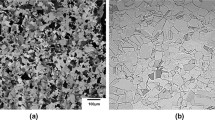Abstract—
Using commercial low-alloy steel as an example, we have studied the nature of the increased scatter in impact toughness in the temperature range of the ductile-to-brittle (D–B) transition by multiple impact toughness tests and examined the microstructure of the steel by electron backscatter diffraction (EBSD). The results demonstrate that the scatter in the impact toughness of the low-alloy steel in the case of fracture in the temperature range of the D–B transition is due to toughness nonuniformity in the plastic zone. To assess the local toughness nonuniformity of the plastic zone in the microstructure of particular specimens fractured in the range of the B–D transition, we evaluated the percentage of the total length of ductile/brittle microcracks. We have demonstrated conceptual feasibility of developing a method for separating the contributions of local plastic deformation preceding and accompanying fracture for particular specimens in the range of the D–B transition using EBSD.




Similar content being viewed by others
REFERENCES
Orowan, E., Energy criteria of fracture, Weld. J. Res.,Suppl., 1955, pp. 157–160.
Shtremel’, M.A., Razrushenie materiala (Fracture of Materials), vol. 1 of Razrushenie (Fracture), Moscow: Mosk. Inst. Stali i Splavov, 2014
Kantor, M.M. and Bozhenov, V.A., Scattering of values of impact toughness of low-alloy steel in the ductile–brittle transition temperature region, Inorg. Mater.: Appl. Res., 2014, vol. 5, pp. 293–302.
Hahn, G.T., Averbach, B.L., Owen, W.S., and Cohen, M., Initiation of cleavage microcracks in polycrystalline iron and steel, Proc. Int. Conf. on Atomic Mechanisms of Fracture, Swamscott, 1959, pp. 91–116.
Mc Mahon, C.J. and Cohen, M., Initiation of cleavage in polycrystalline iron, Acta Metall., 1965, vol. 13, no. 6, pp. 591–604.
Okamura, N., Cleavage fracture of steels with fine grain size, Met. Sci., 1983, vol. 17, no. 12, pp. 581–589.
Chen, J.H., Wang, Y.Z., Yan, C., Ma, H., and Zhu, L., Advances in the mechanism of cleavage of low alloy steel at low temperature. Part I: Critical event, Int. J. Fract., 1997, vol. 83, pp. 105–120.
Kantor, M.M., Vorkachev, K.G., and Solntsev, K.A., Nature of microcracks in ferritic steels occurred during fracture under conditions of ductile–brittle transition temperature region, Inorg. Mater., 2018, vol. 54, pp. 1071–1077.
Shtremel, M.A., Informativeness of measurements of impact toughness, Met. Sci. Heat Treat., 2008, vol. 50, pp. 544–557.
Knott, J.F., Micromechanisms of fibrous crack extension in engineering steels, Met. Sci., 1980, vol. 14, pp. 327–336.
Funding
This work was supported by the Russian Federation Ministry of Science and Higher Education (state research target no. 075-00947-20-00) and the Presidium of the Russian Academy of Sciences (program no. 37P).
Author information
Authors and Affiliations
Corresponding author
Additional information
Translated by O. Tsarev
Rights and permissions
About this article
Cite this article
Kantor, M.M., Vorkachev, K.G. & Solntsev, K.A. Nature of the Scatter in the Impact Toughness of Low-Carbon, Low-Alloy Steel for Fracture under Ductile-to-Brittle Transition Conditions. Inorg Mater 56, 1206–1210 (2020). https://doi.org/10.1134/S0020168520110047
Received:
Revised:
Accepted:
Published:
Issue Date:
DOI: https://doi.org/10.1134/S0020168520110047



